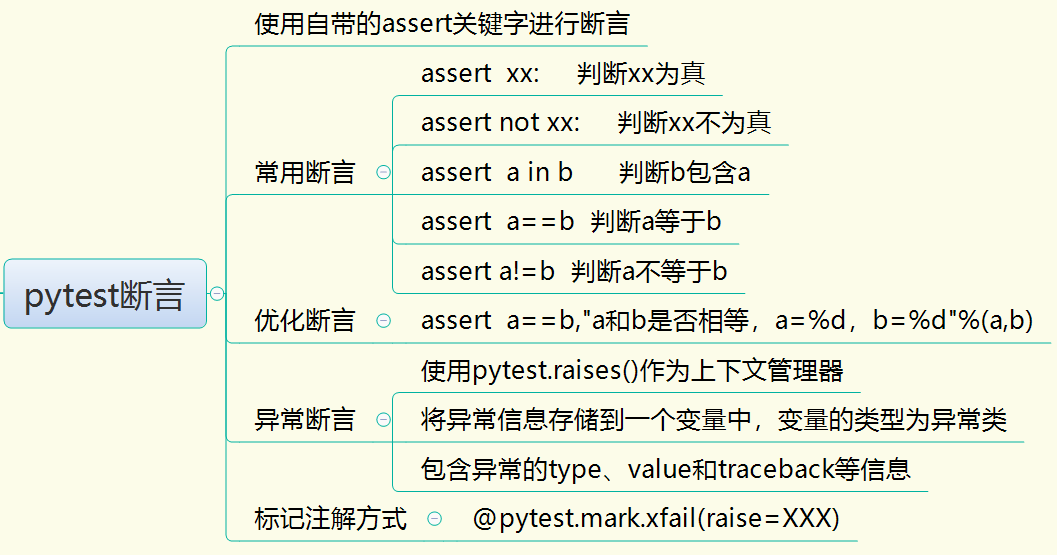Pytest框架断言总结

案例1:使用assert进行断言
"""
pytest框架使用python中的assert进行断言
assert a in b
assert a==b
assert a!=b
assert not a
assert a
"""
import pytest
def fun():
pwd="123479"
return pwd
def test_fun_one():
passwd=fun()
assert len(passwd)==6
def test_fun_two():
passwd=fun()
assert passwd.isdigit()
if __name__ == '__main__':
pytest.main()
案例2:优化断言信息
添加断言自检,这样当断言失败时可以给出错误的提示信息
"""
优化断言,添加断言自检信息
assert 表达式,"错误原因"
"""
import pytest
def fun(a):
return a+10
def test_one():
a=fun(5)
assert a % 2 == 0, "a是奇数,预期a为偶数。a的值是%d" %a
if __name__ == '__main__':
pytest.main()
案例3:异常断言
在使用断言的过程中时常会出现异常,所以可以对特定的异常进行断言
import pytest
def test_excep_value():
with pytest.raises(ZeroDivisionError) as zero:
1/0 #这个是表达式,也可以是方法
print(zero.traceback)
assert "division by zero" in str(zero.value)
assert zero.type==ZeroDivisionError
自定义异常:
import pytest
def is_leap_year(year):
if isinstance(year,int) is not True:
raise TypeError("年份必须是整数")#自定义异常
elif year<=0:
raise ValueError("年份必须大于等于0")#自定义异常
elif(year%4==0 and year%100!=0) or year%400==0:
print("%d年是闰年"%year)
return True
else:
print("%d年不是闰年"%year)
return False
def test_year_one():
with pytest.raises(TypeError) as ex: #断言第一个异常
is_leap_year("hello")
print(ex.typename)
print(ex.traceback)
assert "年份必须是整数" in str(ex.value)
assert ex.type==TypeError
if __name__ == '__main__':
pytest.main()
拓展一:match关键字
将match关键字参数传递给上下文管理器,以测试 正则表达式 是否与异常的字符串表示形式匹配.
注意:这种方法只能断言value,不能断言type
'''
将match关键字参数传递给上下文管理器,
以测试 正则表达式 是否与异常的字符串表示形式匹配.
'''
import pytest
def myfunc():
raise ValueError("Exception 123 raised")
def test_match():
with pytest.raises(ValueError,match=r".* 123 .*") as ex:#这里只能和值比较
myfunc()
print(ex.traceback)
print(ex.typename)
assert ex.type==ValueError
案例4:mark标记注解方式:
@pytest.mark.xfail(raise=XXX)
import pytest
@pytest.mark.xfail(raises=IndexError)#对异常进行断言
def test_one():
x=[1]
x[1]=1
if __name__ == '__main__':
pytest.main()
更多使用方式可以私信我,wx:xiaoshanhu_ck



.jpg)



【推荐】国内首个AI IDE,深度理解中文开发场景,立即下载体验Trae
【推荐】编程新体验,更懂你的AI,立即体验豆包MarsCode编程助手
【推荐】抖音旗下AI助手豆包,你的智能百科全书,全免费不限次数
【推荐】轻量又高性能的 SSH 工具 IShell:AI 加持,快人一步
· 无需6万激活码!GitHub神秘组织3小时极速复刻Manus,手把手教你使用OpenManus搭建本
· Manus爆火,是硬核还是营销?
· 终于写完轮子一部分:tcp代理 了,记录一下
· 别再用vector<bool>了!Google高级工程师:这可能是STL最大的设计失误
· 单元测试从入门到精通